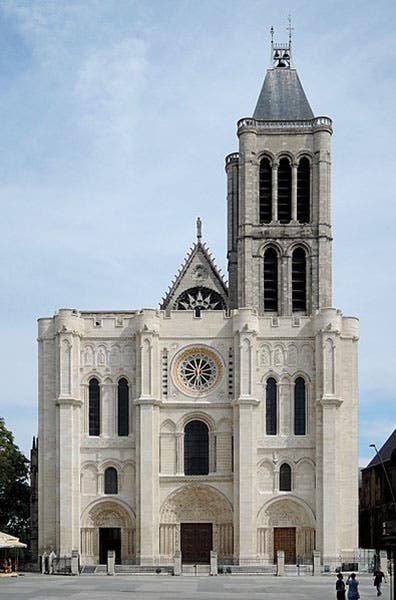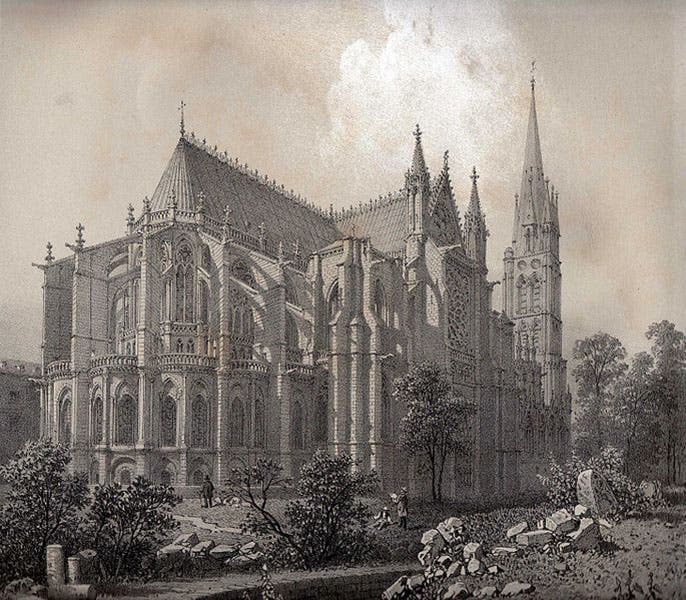Scientist of the Day - Abbot Suger
Abbot Suger, a medieval French cleric, died Jan. 13, 1151, at about age 69; his date of birth is unknown. Suger was Abbot of Saint-Denis in Paris. In 1135, he began rebuilding the medieval church attached to the Abbey. Suger was influenced by the mystical writings of Dionysius the Aeropagite, whom we now call Pseudo-Dionysius, but who was not at all “pseudo” in Suger’s time. Dinoysius was thought to be the Dionysius that Paul converted in Athens, and thus an important early figure in the Church. In his writings, Dionysius argued that one could achieve spiritual presence through light. Accordingly, Suger set out to build a church that admitted as much light as possible.
His first task was to replace the heavy west facade with a lighter one, articulated to show the location of the nave and aisles within, with three doors instead of one, and augmented by a rose window to let in more light. It was not a huge window, but it was a start.
Then Suger tackled the east end of the church. He built a choir for which he used rib vaults in the ceiling, with the ribs radiating out to supporting columns; his architects used pointed arches in place of round ones to better distribute weight, and they added buttresses outside to support the walls. These new architectural elements ensured that the weight of the roof was borne entirely by pillars and columns, allowing the walls to be made of glass – stained glass – and turning them into walls of light (third image). These innovations became essential elements of what would eventually be called the Gothic style.
We often say that Suger invented Gothic architecture, and that’s not wrong, but Suger was not an architect. He had two architect/master masons working for him, turning Suger’s vision into stone and glass, but their names have never come to light. So Suger gets the credit in the absence of anyone to share it with.
It is interesting that natural philosophy (science) underwent a similar transition at the same time. Scholasticism (as we call medieval natural philosophy) was built on the same principles as Gothic style: an emphasis on order and articulated structure (but with little interest in harmony), with a desire for light and clarity. This was noticed many years ago by Erwin Panofsky in his book, Gothic Architecture and Scholasticism (1951), and his thesis that Gothic and Scholasticism share many essential elements has held up well over time. It is tantalizing to consider the possibility that the philosophy of Thomas Aquinas and Albertus Magnus was ultimately engendered by the vision of the Abbot of Saint-Denis. There are no contemporary portraits of Abbot Suger; we have only the rendition in glass in one of the stained-glass windows of the cathedral of Saint-Denis (first image). Dr. William B. Ashworth, Jr., Consultant for the History of Science, Linda Hall Library and Associate Professor emeritus, Department of History, University of Missouri-Kansas City. Comments or corrections are welcome; please direct to ashworthw@umkc.edu.








![Using an astrolabe to measure the depth of a well, woodcut in Elucidatio fabricae vsusq[ue] astrolabii, by Johannes Stöffler, 1513 (Linda Hall Library)](https://assets-us-01.kc-usercontent.com:443/9dd25524-761a-000d-d79f-86a5086d4774/a998eb50-55d2-4a88-ace2-a50aa5fa86e7/Stoffler%201.jpg?w=210&h=210&auto=format&fit=crop)

